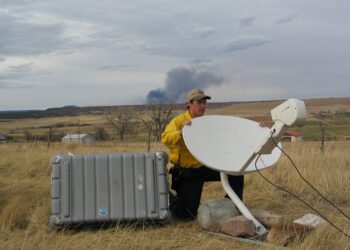Magma, volcano in Yellowstone likely more stable than expected
By Brandon Schmandt and Chenglong Duan DAILY MONTANAN
When standing in many places in Yellowstone National Park, the signs of a buried heat source are unmistakable, making one inclined to wonder “how far beneath my feet is there magma?”
The answer is important to fundamental science questions about magma reservoirs as well as for understanding the potential hazards from Yellowstone. And, it’s just a darn interesting question, too!
There is a long history of physical and chemical measurements that provide evidence for magma beneath Yellowstone caldera, with estimates for the depth to the top of the reservoir ranging from about 3 to 9 kilometers (about 2 to 5.5 miles) beneath the surface. Most prior seismic imaging estimated a smooth 3-D structure that is informative regarding the approximate size, shape, and location of magma storage. A limitation is that the resulting edges of the reservoir are blurry. Sharpening the view is important, as better knowledge of the depth and characteristics of the top of the magma reservoir would give additional insights into magma storage and release of magmatic gases.
To obtain that sharper view of the top of the magma reservoir, to determine its depth, and whether it is marked by a gradual or sharp transition, a group of seismologists used a controlled seismic source and hundreds of seismometers to image the subsurface. The “controlled source” was a 53,000-pound truck with a vibrating hydraulic plate that creates seismic signals, like tiny custom earthquakes. During the summer of 2020, the truck created these custom earthquakes on numerous paved roadside turnouts throughout the caldera. The work was done in the middle of night to avoid impacting park visitors, both from the minor ground vibrations and any traffic delays. The seismic signals created by the truck were measured at several dozen permanent Yellowstone Seismic Network stations, as well as about 600 temporarily installed seismometers that were deployed along roads and trails specifically for this seismic experiment. The seismic waves generated by the truck were tuned to bounce off the magma chamber, with the data from that reflection hopefully providing new insights into just where the top of the magma chamber is located and what it looks like.
The results are in, recently published in the journal Nature. The answer? There is a very sharp transition marking the magma chamber top at about 3.8 km (2.4 miles) depth beneath the northeastern part of the caldera near the Yellowstone River.
Beyond locating the top of the magma reservoir and determining that the boundary is less than about 100 meters thick, the seismologists estimated the concentration and type of fluids present at the very top of the reservoir. They found that a two-part mixture of only magma and solid mineral crystals would not fit the strength of the reflected seismic signals, but a three-part mixture with supercritical fluid bubbles, magma, and solid mineral crystals can explain the reflections much better. This result is consistent with geochemical models that indicate bubbles would be coming out of magma stored at depths as shallow as 3.8 km (2.4 mi). At greater depths, and correspondingly greater pressures, the elements that form the bubbles would stay dissolved within the magma. But at the depth measured from the new seismic data, bubbles would emerge from the magma and rise to form a cap layer atop the magma reservoir.
That might sound alarming—bubble accumulation in magma reservoir can be an important step toward creating the conditions suitable for eruption—but it depends on the concentrations of magma and bubbles. Fortunately, the Yellowstone magma system appears to be in a stable configuration. The seismic reflection results suggest about 14% fluid and about 86% solid crystals in the cap layer of the reservoir. Under these conditions, bubbles are expected to rise efficiently toward the surface, which prevents excessive build-up of pressure. And indeed, this fits with gas measurements that find magmatic gases emitted at the surface in many areas of Yellowstone National Park.
Finding evidence for bubbles atop the Yellowstone magma reservoir gives new perspectives that align with the long-term view of a magmatic system that is mostly solid and currently stable. The results also highlight that it may be within reach to measure bubble accumulation beneath volcanoes in general, demonstrating once again that using Yellowstone as a natural laboratory can help better understand volcanoes and their eruptions elsewhere on Earth.














